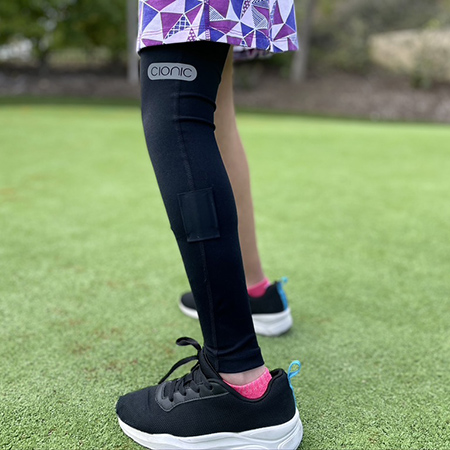Start-Up Spotlight: Jeremiah Robison Turns Cerebral Palsy ‘Passion Project’ Into Full-Time Commitment
Executive Summary
The CEO of Cionic developed a garment used to analyze and augment human movement for people with stroke and cerebral palsy with plans to file for US FDA 510(k) clearance this fall.
Jeremiah Robison is on his way to transform his passion project to help his daughter, who was diagnosed with cerebral palsy at 14 months of age, into a medical-grade device to help others with mobility issues.
The CEO of San Francisco-based Cionic and his team are developing a garment or “Neural Sleeve” that uses smart sensors to analyze a patient’s current mobility and combines that with functional electrical stimulation (FES) to activate the body’s own muscles for more natural movement. Gait analysis plays an important role in the clinical decision-making when treating children with cerebral palsy.
Cionic's Neural Sleeve
 Cionic's Neural Sleeve
Cionic
Cionic's Neural Sleeve
Cionic
The analysis is typically done in a clinical setting with physical therapists using tools such as video analysis, 3D kinematic measures of the joint motion and electrical stimulation to assess patients. But outside the lab, there are very few solutions to help patients address their mobility problems and to gain independence outside of using crutches, canes and wheelchairs as Robison learned himself looking for treatment options for his daughter.
A computer scientist who had worked on early web browsers at the tech giant Apple Inc. and spent seven years as VP of Software at Jawbone developing the UP Fitness Band, which tracks vital signs and other functions, Robison said he woke up one day and said to himself “if not me, who and if not now, when?” He left Jawbone in 2017 to pursue his passion project.
"I started working for the first six months just by myself in the garage building prototypes … the big thing for me is this is both a career and it’s also a commitment to my family and I wanted to make sure it’s not just a pipe dream,” Robison told Medtech Insight.
After six months, Robison developed the first viable prototype and raised a seed round of $3m from Caffeinated Capital, which he used to start Cionic in 2018 with co-founder Brian Kolonick, who previously worked at the American Stroke Foundation and Cleveland Clinic. By the end of 2019, Robison and his team built a second prototype that showed a 70% improvement in his daughter’s gait metrics.
The company is now on its fifth-generation prototype, which will be used to conduct clinical studies. The trials will enroll 40 to 50 patients with mobility impairment – not restricted to cerebral palsy – to evaluate various gaits. The trials involve two sessions of 60-90 minutes each. The first session aims to confirm that the algorithms for assisting gaits are accurate. The second session involves a gait analysis by looking at trial participants’ natural gait pattern unassisted versus using the Neural Sleeve using stimulation.
“They’re being compared to themselves with and without our technology,” Robison explained. He plans to use a sub-set of the data from trial participants across mobility impairments to file for 510(k) clearance with the Food and Drug Administration for use with patients of diverse mobility impairments.
“The FDA does not have strict requirements around efficacy – their focus is primarily on safety,” he explained. “We are working to not only meet but exceed the FDAs requirements on safety and efficacy.”
To establish efficacy, Cionic is also working with investigators at Oakland, CA-based Samuel Merritt University’s Motion Analysis Research Center on validation studies comparing Cionic’s system to the gold standard, which uses optical tracking systems to measure 3D lower-limb joint motions.
Robison said that the current prototype is not quite ready for prime time.
“It’s still in the product development cycle,” he said. “The material is not yet robust enough to sustain eight hours of continuous daily wear, which is the goal. We are now testing form factor leg sleeves in our user trials.”
The Cionic “Neural Sleeve” has three layers – the garment itself, which can be handwashed, and ideally can be worn for 12-18 months; the electronics, which looks like a “sleek cell phone” that can be charged; and the electrodes that need to be replaced monthly.
The device is designed so it can be programmed by a physician to meet the needs of individual patients. The prescribed settings can be adjusted remotely by the physician, based on an analysis report that is emailed to the neurologist. The patient would use an app to do prescribed physical therapy exercises at home and then use stimulation to help augment the therapy, Robison explained. The Neural Sleeve allows patients to just go about their day and experience “more free living support.”
“What’s great about motion analysis and specifically neural-motion analysis is understanding how the muscles are firing and then analyze that in real time to understand where the deficiencies are and fill in the gaps with functional electrical stimulation and thereby creating a system that can work … out in the real world,” Robison said.
Some 33 million people in the US, or 1 in 7 Americans have disabilities related to mobility, according to the Center for Disease Control and Prevention (CDC). Cionic’s initial target markets will be stroke patients, which affects more than 790,000 people in the US every year with 610,000 of these being first or new strokes, according to CDC figures; and cerebral palsy, the most common motor disability in children, affecting about 1 in 345 children in the US, according to 2010 estimates from CDC’s Autism and Developmental Disabilities Monitoring (ADDM) Network. (Also see "Market Intel: Exoskeletons Stretch Into Stroke And Mobility Rehab Markets To Ramp Up Growth " - Medtech Insight, 4 May, 2018.)
“Those are the initial markets we’ll go after, and then, as we progress and can prove more clinical efficacy, we will start expanding into some of the more progressive diseases and then into the general geriatric community,” Robison said.
Challenges Ahead
One of the biggest barriers to market entry, however, is the lack of reimbursement. Patients would need to pay for the device upfront and then pay an additional monthly subscription fee for the software upgrade embedded in the electrodes.
“A lot of technology that’s coming to market is investigational, it’s really hard for families to access it [due to out-of-pocket cost]. “To get to scale, especially in this country, reimbursement is key. Our goal is to make it affordable,” he said. He noted that currently available systems cost in the “tens of thousands of dollars.” He expects Cionic’s product will run in the “hundreds of dollars.”
In terms of marketing, “Because this is a prescription-only product, clinicians play a big part in advocacy for a solution like this.”
“A lot of technology that’s coming to market is investigational, it’s really hard for families to access it [due to out-of-pocket cost]. To get to scale, especially in this country, reimbursement is key. Our goal is to make it affordable.” – Jeremiah Robison
Once the product is cleared by the FDA, the company will partner with clinics to do early pilots, then bring it to neurologists and physical and occupational therapists who work with stroke and cerebral palsy populations. Robison noted because FES is a known modality that has been used in labs for a long time, he has found that neurologists are supportive of a system that can be used at home, which is “really encouraging.”
The resurgence of COVID-19 has also created challenges in terms of being able to recruit patients into clinical trials. However, Cionic now has 20 participants enrolled in trials across pediatrics and adults and is looking to enroll more patients.
The garment design also poses mechanical challenges. A garment is designed to be unobtrusive or as Robison puts it “discreet enough to be worn under your clothes but fashionable enough to show off.”
Despite these challenges, Robison is hopeful to introduce the Neural Sleeve into clinics this year, pending regulatory clearance.
“According to the World Health Organization, 1 in 5 people will suffer from a mobility challenge by 2050. It’s a large group of people and we’ll count ourselves fortunate if we can have an impact on even just a small slice of those folks.”
